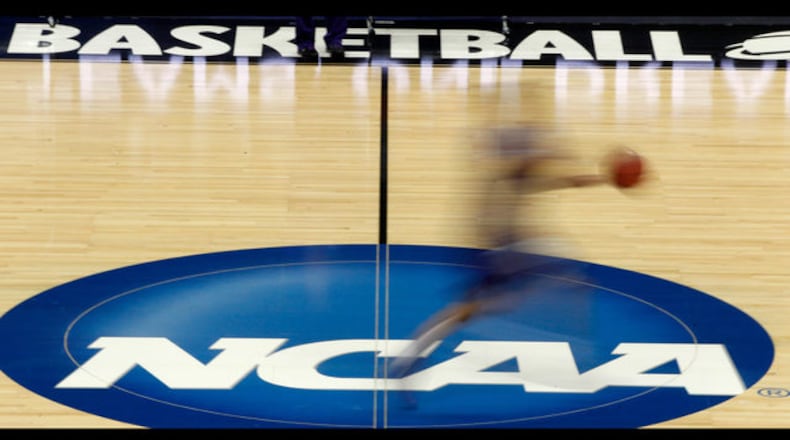For many decades, the NCAA strictly enforced rules against college athletes being paid for endorsements, autographs and the like. Such restrictions were lifted last summer, ushering collegiate sports into a new era in which athletes can monetize their fame without risking their eligibility. A look at how the change happened, how it’s evolving and what’s next:
Sept. 30, 2019: California becomes the first state to pass a law allowing college athletes to be paid for use of their names, images and likenesses (NIL). Gov. Gavin Newsom calls the Fair Pay to Play Act, initially set to take effect in 2023 and later accelerated to September 2021, “the beginning of a national movement.” NCAA officials call it “harmful,” “unconstitutional” and an “existential threat” to college sports.
Oct. 29, 2019: With more than 20 other states considering laws similar to California’s, the NCAA’s top governing body meets in Atlanta and vaguely asks each NCAA division to create new NIL rules “in a manner consistent with the collegiate model” by January 2021.
June 12, 2020: Florida passes a law granting NIL rights to college athletes with an effective date of July 1, 2021, the earliest of any state law at this point.
Jan. 11, 2021: The NCAA backs off its commitment from the October 2019 meeting in Atlanta to enact new rules by January 2021. It attributes an indefinite delay to antitrust concerns raised by the U.S. Department of Justice.
Credit: Greg Bluestein/AJC
Credit: Greg Bluestein/AJC
May 6, 2021: Georgia Gov. Brian Kemp signs into law legislation passed by the General Assembly to give college athletes in this state the right to make money from endorsements and related activities. “It sets Georgia on the path to accomplish something that, quite honestly, should have been done a long time ago,” Kemp says. Georgia becomes the 12th state to pass such a law and the fifth, following Florida, Alabama, Mississippi and New Mexico, to set an effective date of July 1, 2021.
June 21, 2021: The U.S. Supreme Court rules unanimously that the NCAA can’t limit education-related benefits to athletes. Although the case, Alston vs. NCAA, doesn’t directly involve NIL or pay-for-play, the court’s decision is seen as setting the stage for further legal challenges to rules limiting athlete compensation. “Nowhere else in America can businesses get away with agreeing not to pay their workers a fair market rate on the theory that their product is defined by not paying their workers a fair market rate,” Justice Brett Kavanaugh writes. “The NCAA is not above the law.”
June 1-30, 2021: Seven additional states pass NIL laws, bringing the total to 27. The laws are largely similar, but with differences in what’s allowed and effective dates (13 are set to be implemented on July 1, 2021).
June 9, 2021: NCAA President Mark Emmert testifies before a U.S. Senate committee and, to no avail, reiterates his plea for Congress to pass a federal law that would supersede the various state laws. “The states have taken it upon themselves to do what the NCAA has proven incapable of doing,” Sen. Marsha Blackburn (R-Tenn.) tells Emmert.
June 30, 2021: On the eve of the new laws taking effect in Georgia and other states, the NCAA suspends its previous NIL rules and announces an “interim” policy allowing athletes across the nation to be paid for their fame. The NCAA says athletes in states with applicable laws “can engage in NIL activities that are consistent with the law of the state where the school is located” and instructs schools in other states to set their own guidelines with minimal restrictions. The NCAA stresses that rules against pay-for-play and recruiting inducements still stand.
July 1, 2021: College athletes across the nation begin signing endorsement deals. The new laws take effect in Alabama, Connecticut, Florida, Georgia, Illinois, Kentucky, Louisiana, Mississippi, New Mexico, Ohio, Oregon, Pennsylvania and Texas. And in all other states, the “interim” NCAA policy takes effect.
Dec. 6, 2021: A new entity called “Horns with Heart” announces plans to offer University of Texas offensive linemen $50,000 in “annual financing per player” to participate in charitable endeavors “utilizing their name, image and likeness.”
Feb. 3, 2022: Alabama becomes the first state to repeal its NIL law, doing so because its legislation proved to be more restrictive than the “interim” NCAA policy for schools in states without such a law. (Georgia’s law included a provision rendering it “null” if the NCAA adopted a policy allowing athletes to receive NIL compensation, so athletic programs in this state now can operate under the NCAA policy.)
Feb. 18, 2022: Less than eight months into its NIL era, the NCAA says it will begin a review of how recruiting and other aspects of college sports are being affected.
Next: The NCAA expects to have a preliminary report on the impact of NIL in April and a final report, including recommendations for possible action, in June. Any step to significantly restrict the marketplace likely will bring litigation. The NCAA also continues to ask Congress to pass federal legislation. Meanwhile, many college athletes continue to reap the rewards of their names, images and likenesses.
About the Author
Keep Reading
The Latest
Featured




